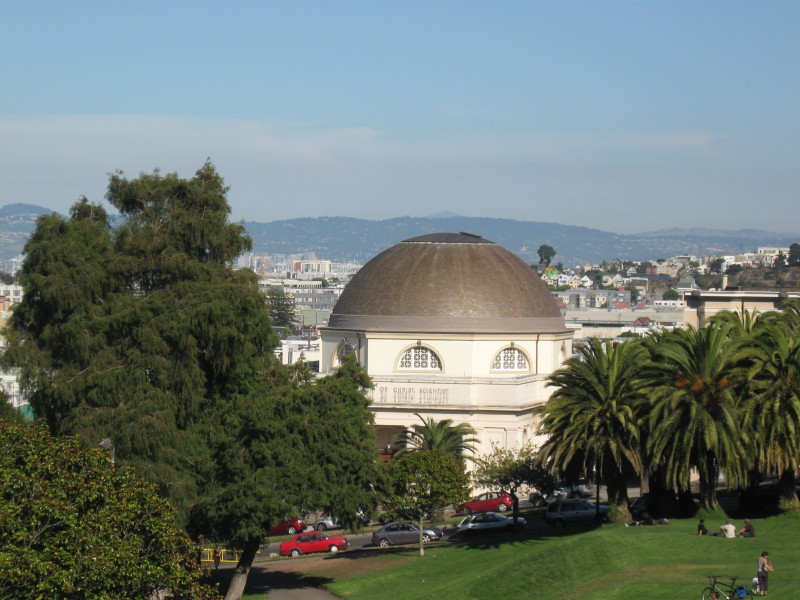 Our home in San Francisco is close to Dolores Park, a beautiful sloping green hill with postcard views of the city skyline. The park is famous for San Francisco’s oldest building, the Mission Dolores (a couple blocks away), the trendy Mission District and the ‘Hunky Jesus’ contest staged in the Park every Easter Sunday.
Our home in San Francisco is close to Dolores Park, a beautiful sloping green hill with postcard views of the city skyline. The park is famous for San Francisco’s oldest building, the Mission Dolores (a couple blocks away), the trendy Mission District and the ‘Hunky Jesus’ contest staged in the Park every Easter Sunday.
Looking over the Park to the opposite side of Dolores Street sits the Second Church of the Christ Scientist, a classical dome structure (photo above) built in 1905. Even though the Church survived the 1906 earthquake and the consequent fires that leveled most of the city, it didn’t survive the ‘Will of God’. The congregation eventually grew smaller and the great domed church was sold in 2012. It’s now being reborn as 4 luxury loft apartments.
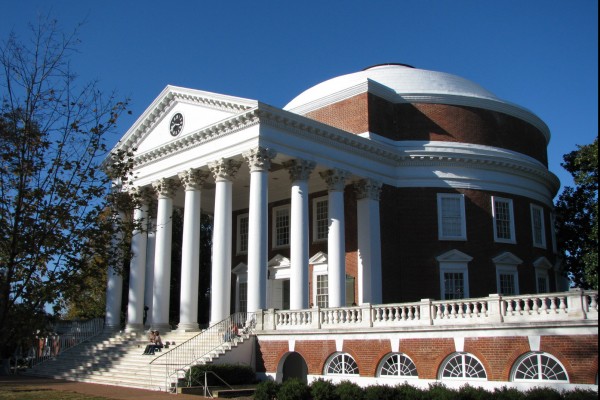
The view of the church from the park always reminds me of Rome’s Pantheon. It’s the dome. The Pantheon Dome has become the inspiration for Classical Revival buildings throughout the world; Brunelleschi’s Duomo (Basilica di Santa Maria del Fiore) in Florence, Michelangelo’s Dome of Saint Peters Cathedral in the Vatican, The Hagia Sofia and the Suleymaniye Mosque of Istanbul, Christopher Wren’s St Paul’s Cathedral in London, the US Capitol Building in Washington DC and Andrea Palladio’s Villa Almerico-Capra (La Rotonda) near Vicenza to name a few. Thomas Jefferson was so inspired by the Pantheon, he used it in the design of his home in Monticello, and the ‘Rotunda’ at the University of Virginia (right photo) . Jefferson is so associated with the dome it became the iconic feature of his memorial in Washington DC.
The first temple built on what’s now the Piazza della Rotondo was in 717 BC, near the site where Romulus was picked up by the Eagle of Jupiter and carried off to the Gods. The story is a great part of the Romulus (founder of Rome) mythology. In reality, Romulus had many enemies and it was very likely he was killed in the Campo Marzio, his body chopped up and disposed of, but the legend is a much better story. The first temple, like many of the early buildings of Rome, was made of wood. It burned down. Fires were a common setback to urban planning.
In 27 BC, Marcus Vipsanius Agrippa, childhood friend, son-in-law of Emperor Augustus, and Gretchen’s personal hero paid for the construction of a new Pantheon Temple (from the ancient Greek word for ‘all of the gods’) when he was Consul for the third time. From what we know about this one, it was a 144’ x 66’ rectangular T-shaped building with brick walls and a wooden roof that burned down in the great fire of 80 AD.
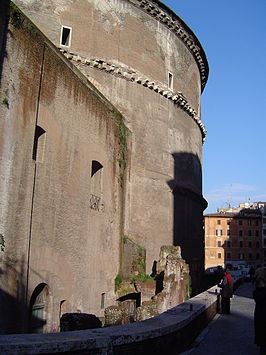
The fire of 80 AD also took the Saepta Julia, the grand rectangular hall used as a public marketplace, voting hall and gladiatorial games during the reign of Augustus. The 80 AD fire wasn’t as big as the Great Fire of 64 AD but it did have the added sadness of coinciding with a plague. The building damage might have been smaller, but the population death was worse.
Part of the rebuilt rectangular Saepta Julia is still attached to the Pantheon. The Agrippa version was also destroyed in the fire of 80 AD. You can see it on the backside along via Palombella (see photo to right).
The Pantheon was rebuilt under the Imperial reign of Titus and finished by Domitian, the last of the Flavian line but his new version was struck by lighting and burned down in 110 AD.
In 118 AD the Emperor Hadrian started the construction of an entirely new Pantheon over the foundations of the Agrippa building. It took almost 10 years to complete which is a really long time for construction in ancient times. The Colosseum took 10 years to complete.
We really don’t know why he gave credit to Agrippa. Some think it was to connect himself with the original imperial line of Augustus. Maybe he just had a great sense of humor. The new version was nothing like the Agrippa’s but nonetheless, the dedication on the lintel under the entrance pediment has confused travelers for over 1880 years. It reads:
M∙AGRIPPA∙L∙F∙COS∙TERTIVM∙FECIT
Marcus Agrippa Lucii) Filius con sul tertium fecit
Marcus Agrippa, son of Luciuus, made this building when he was consul for the third time.
The pediment above the inscription was once filled in with a carved marble scene of the Roman Gods, possibly covered in gold but it was removed, probably just before the consecration of the Pantheon as a church in 609.
The architect of the Pantheon is usually listed as ‘unknown’. There are many historians who think the Pantheon was just too good for an amateur architect like Hadrian. Some think Apollodorus of Damascus was the master architect. I believe it was all Hadrian. I prefer to think that Hadrian was an incredibly gifted man of the arts and well capable of a design like the Pantheon, although he did probably have some help. All great architects have great assistants. You just never hear about them.
Hadrian’s designs at the Villa Adriana (Hadrian’s Villa) retreat in Tivoli, his Temple of Venus and Rome at the base of Palatine Hill, his Mausoleum (now the Castel Sant’Angelo) and the Pantheon are just a few testaments to his architectural talents.
He took his inspiration from Riberius, the master architect of Domitian’s Flavian Palace on the Palatine Hill and from Trajan’s architect, Apollodorus of Damascus. Hadrian so desired Apollodorus’ approval and encouragement, but the great master cast him aside as an annoyingly crude amateur.
According the historian and Roman Consul, Cassius Dio (155–229), when young Hadrian sent Apollodorus the design of the domed Egyptian Serapeum temple he planned to build at his Villa retreat, the great architect wrote back, “go away and draw your pumpkins, you know nothing of architecture”. At this point Hadrian was the adopted son of Trajan.
When Hadrian showed the designs for the Temple of Venus and Rome to the great Apollodorus, the master scoffed at it and said not only was the Temple platform built too low, but if the gods sitting in the niche chairs ever decided to stand up they would hit their heads on the ceiling. At this point, Hadrian was the Emperor who had his fill of the egotistical old bastard and banished him from Rome. A short while later he gave the order to have Apollodorus assassinated. There are only so many insults you can sling at the Emperor.
Michelangelo said he based many of his architectural concepts on the designs of Hadrian, so did Palladio and Thomas Jefferson. In fact, Michelangelo had such respect for Hadrian’s Pantheon, he made his Dome of St Peter’s at 139’ in diameter, 3’ less than the 142’ diameter of the Pantheon’s dome roof.
In 202 AD, the Pantheon was restored again by Emperor Septimius Severus. We really don’t know what was done but the Emperor was sure eager to tell everyone about it. His (very long) dedication sits at the bottom of the same lintel that bears Agrippa’s dedication. You have to look closely to see weathered chiseled lettering, but as faded as it might be now, it was pretty boastful when it went up.
It’s translation:
The Emperor Caesar Lucius Septimius Severus Pius Pertinax, victorious in Arabia, victor of Adiabene, grand victor of Parthia, Pontifex Maximus, 10 times tribune, 11 times Emperor, three times consul, Pater, Patriae, proconsul and Emperor Caesar Marcus Aurelius Antoninus Pius Felix Augustus, five times tribune, consul, proconsul have carefully restored the Pantheon that was ruined by age.
Emperor Caesar Marcus Aurelius Antoninus is known by his nickname, Caracalla, named after the toga hoody he wore and made fashionable.
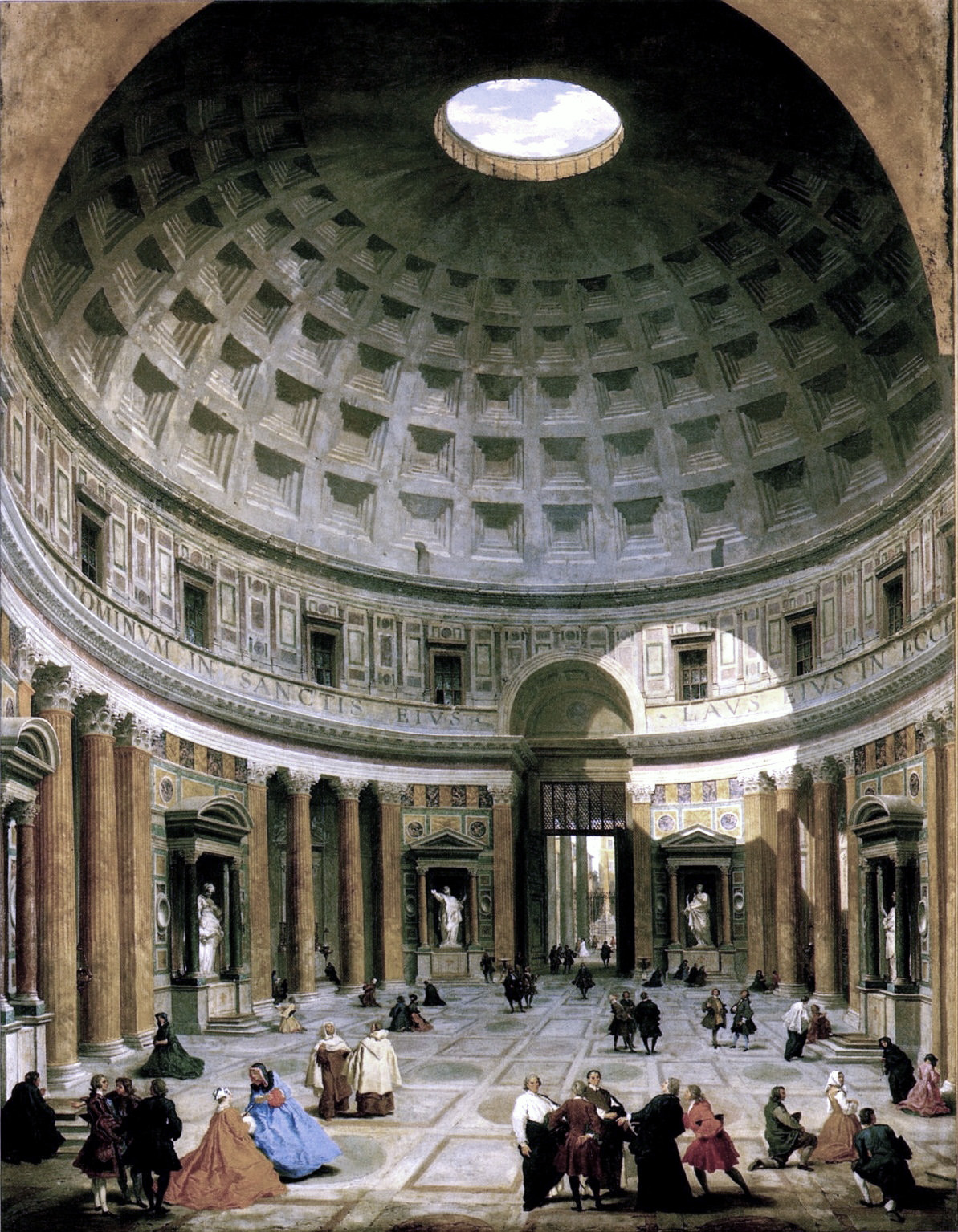
To me, the Pantheon is perfect, as tall (142’) as it is wide (142’). The Giovanni Battista Piranesi print of the Pantheon in our house is in a place that we look at every day. We never tire of it. It always reminds us of how much we love this building and this Piazza.
The cylindrical building is made of a concrete mixture of lime, pozzolanic (volcanic) ash, pumice and stones. It was once covered in white stucco to make it appear like white marble but all traces of the finish is long gone.
The single span concrete dome weighs over 5,000 tons even after the underside of the dome was coffered to further reduce the weight. The 27’ diameter Oculus, ‘Eye of Jupiter’, is the only source of light and it provides more than enough even on rainy and cloudy days.
We’ve seen snow through the Oculus in December. It’s a magical experience.
On April 21st, the traditional day of the founding of Rome, at exactly 12:00 noon, the sunrays move from the Oculus right through the front door. The painting above is by the 18th century painter, Giovanni Panini.
The 22’ tall bronze entrance doors weigh 20 tons each. They might not be the original ones that were once covered in gold but they are definitely of the same age as the building.
The Pantheon was built over a marsh. It has withstood fires, earthquakes, the rumbling of trucks and millions of tourists. It is always packed with visitors and yet it is the most peaceful place in all of Rome.
The multicolored marble floor was designed in the ornate style of the Flavians and restored in 1873 (the original design kept in tact). The floor is a graceful convex bowl designed to encourage the drainage from rain through the Oculus into drainage holes through the marble tiles.
My all time favorite story of how the building was constructed comes from the 13th century collection of tales on the life of the saints known as ‘The Golden Legend’. It was added to and reprinted up to the 16th century. According to the one story of the book, the dome was raised on top of a massive mound of dirt filled with gold coins. After the dome had been secured, the Roman people were allowed to dig out the dirt and keep the coins for themselves.
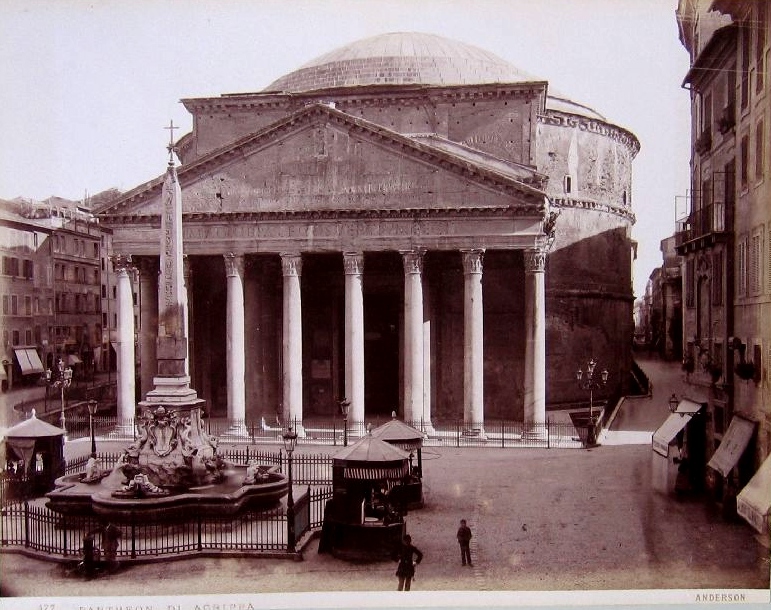
The enclosed porch at the entrance was supported by (16) 40’ tall Egyptian grey granite columns decorated with intricately carved Greek Pentelic Corinthian capitals. Pentelic marble (from Mount Pantelakos) was the same marble used to build the Acropolis in Athens. Hadrian was such a Greek enthusiast, he even imported Greek sculptors to sculpt the Corinthian capitals.
In the original design the columns were 50’ tall which would have raised the front pediment to the top of the top of the front cornice, which makes more sense. The 50’ columns never arrived. No one knows if the ship sank or the columns broke but the design was changed and the front portico dropped down 10’. As I mentioned, the building took almost 10 years to finish. I’m sure there were a lot of changes along the way.
The photo above is from the 1860’s by the British photographer, James Anderson.
Over time three columns on the left side fell and were replaced. One was replaced in 1626 with a column from Domitian’s villa at Castelgandolfo. The other two came in 1666 with columns from the 64 AD Baths of Nero (rebuilt as the Baths of Emperor Alexander Severus in 227 AD). They’re more noticeable because of their rose pink color while the others are grey. It’s subtle and there is so much to look at, you might not even notice.
In 608, Phocas, the illegitimate usurper Emperor of the Eastern Empire reinstated Smaragdus to the position of Exarch (Governor) of the Byzantine city of Ravenna and donated the Pantheon to Pope Boniface IV of Rome. For these gracious acts, Phocas was rewarded a re-appropriated, reused and refashioned splendorous golden statue on a 44’ tall column in the ancient Forum. The pedestal can still be seen near the Rostrum. It was the last Imperial addition to the ancient Forum. The Golden Statue probably never lasted much longer than Phocas who was seized by a mob in Constantinople, lynched and dragged through the streets in 610.
On 13th of May, 609, Pope Boniface IV “cleared out the pagan filth” by removing all the ancient Roman statues and consecrated the building to Saint Mary and the Martyrs. In one story, 28 wagon loads of bones were brought from the catacombs and placed inside the dome to be sanctified.
In another great story from the Middle Ages, the dome was originally covered with a bronze plate topped with a large bronze pinecone, but when Boniface IV sanctified the building, the demons living inside blew the pinecone off the building and escaped through the hole. The brass pinecone of the story is now the centerpiece in the Belvedere Courtyard of the Vatican Museums. The Roman District that includes the Piazza della Rotondo and the Pantheon is still referred to as the Rione Pigna (the pinecone district).
In 663, The Eastern Roman Emperor Constans II came to Rome for a 12 day sight seeing holiday. He toured the ancient wonders, carved his name at the top of Trajan’s column and again at the top of the Arch of Janus Quadrifons and left the city laden with cartloads of bronze to forge into new weapons. Included in the booty were the gilded bronze tiles that once covered the exterior of the Pantheon’s dome. He loaded it all into ships and sailed to Syracuse were some say he was planning on building a new Roman capital. In 668, the city was attacked by Saracens. Constans II was killed and the gilded bronze tiles were gone forever, supposedly taken to Alexandria.
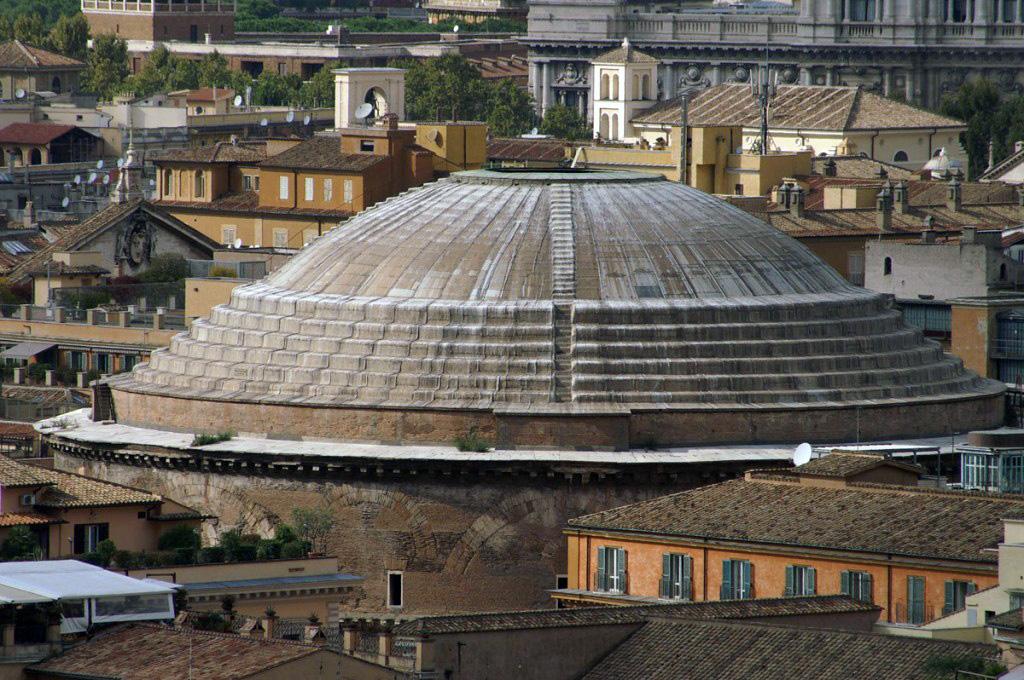
It took over 70 years before Pope Gregory III raised the money to replace the missing tiles with a lead covering that’s still up there today.
In 1632, Pope Urban VIII (Maffeo Barberini) removed close to 200 tons of ancient bronze from the underside of the portico roof. The original excuse was to lighten the weight of the decaying structure but in fact, he offered the bronze Gianlorenzo Bernini to use in the grand twisted Baldachin over the high alter of Saint Peter’s Cathedral. Bernini said the bronze was inferior for his use so the ancient metal was melted down and re-cast into 80 canons to defend the Castel Sant’Angelo. Soon after the most famous ‘Pasquinade’ every written was posted to Pasquino, the foremost talking statue of the city:
Quod non fecerunt barbari fecerunt Barberini
“What the Barbarians didn’t do the Barberini did”.
Pope Urban VIII’s response was “the metal was better employed keeping away the enemies of Holy See than keeping the rain off the Pantheon’s porch”.
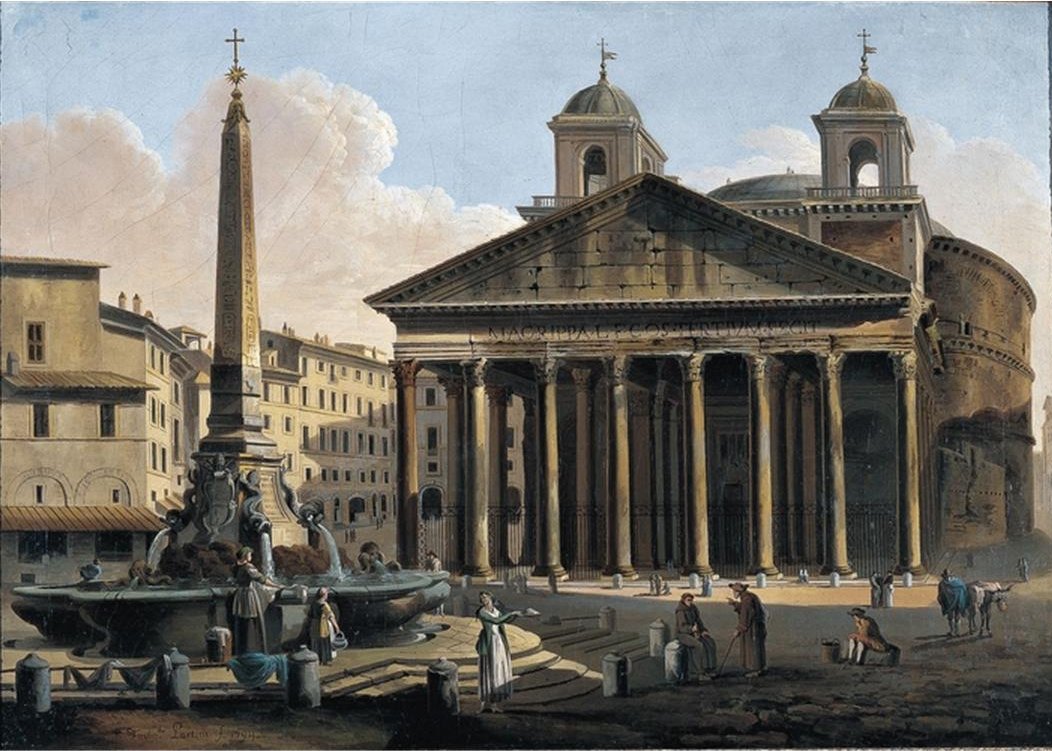
It’s been said that to appease the Roman people for the bronze theft, Urban VIII decided to beautify the Pantheon and ordered the construction of two twin bell towers, unflatteringly referred to as ‘le Orecchie d’asino’ (Donkey ears). In later years they were referred to as ‘Bernini’s Donkey Ears’, which was totally undeserved.
It’s true Gianlorenzo Bernini was Urban VIII’s favorite architect so it might have been a natural assumption that it was his design. However, Bernini actually spoke out against the project and refused to take it. It was probably the work of Carlo Moderno. At any rate, the ‘Donkey Ears’ were removed during the restoration of 1882.
The painting above of the Donkey ears on the Pantheon is from 1794 by Ferdinando Partini.
During the Middle Ages of Rome’s noble families used the Pantheon as a Fortress of protection against their enemies who were camped out in their Fortresses inside other monumental buildings like the Coliseum or the Castel Sant’Angelo. In one occasion during the 11th Century the Pantheon was actually used as head quarters and refuge to an anti-Pope Clement III in his attempts to outdo the “legitimate” Pope Gregory VII.
During the Renaissance it was customary to climb the outside of the building and look down through the Oculus. One notable visitor was the Holy Roman Emperor Charles V who a few years earlier in 1527 had sacked the city and was now on a return visit requesting the Pope’s pardon.
In the 15th century, Raphael made it very fashionable to be interred inside.
Raphael died on Good Friday, April 6, 1520 after a debaucherous night of sex and drink with his true love, Margherita Luti, known as ‘La Fornarina’. It was his 37th birthday. His tomb is probably the most visited (or sought out) highlight of the building.
His corporal remains lie in a sarcophagus under the statue of the “Madonna of the Stone” (Madonna del Sasso) sculpted by one of his friends, Lorenzo Lotti (Lorenzetto) and Raffaello da Montelupo, an apprentice of Michelangelo. The ‘stone’ of the statue is where Mary is resting her left foot.
The inscription on the tomb was written by Raphael’s friend Cardinal Pietro Bembo.
“Ille hic est Raphael, timuit quo sospite vinci, rerum magna parens et moriente mori“.
“Here lies Raphael. Mother Nature feared to be bettered by him when he lived and feared to die with him when he died”.
By the way, Margherita Luti (La Fornarina) was not invited to the funeral.
In 1536, the painter and architect, Baldassare Peruzzi was interred next to old friend, Raphael.
In 1609, the great Baroque painter Annibale Carracci joined them and in 1713, the Baroque composer and violinist Arcangelo Corelli was added to the group.
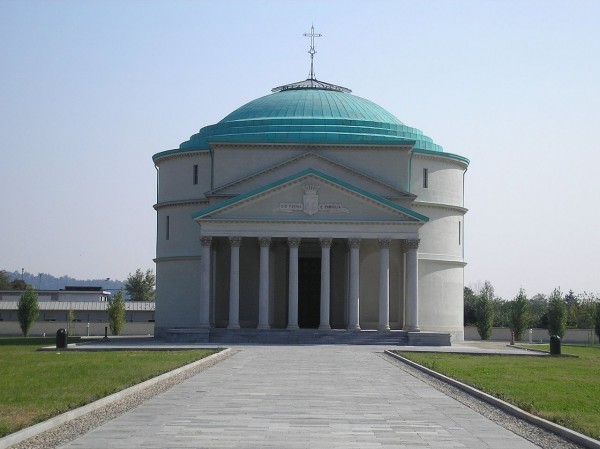
In January 1878, Vittorio Emmanuel II, the first King of Unified Italy, had just refused a meeting with Pope Pius IX, who might have reversed the King’s excommunication from his war on the Papal troops during his conquest of Italy. We don’t know why the meeting was cancelled but the King died a few days later and was buried with all pomp and circumstance in the Pantheon. When his second wife, Rosa Teresa Vercellana (La Bella Rosina) died in 1885, the King’s Savoy family refused to have his mistress/second wife buried next to him and so her children had a mini Pantheon built for her in Turin. It’s still there. After the mausoleum was purchased by the city of Turin, it was opened to the public, which turned out to be a really big mistake. Within two years, the remains of the Rosa and her family were destroyed by grave robbers looking for old family jewels. After subsequent years of cruel vandalism the mausoleum was restored in 2005.
King Vittorio’s son, the grand mustachioed, King Umberto I is interred right beside his father. Although Umberto I was assassinated in the northern city of Monza in 1900, his ghost seems to have followed his final remains and is now rumored to haunt the Piazza della Rotonda.
It was King Umberto who said: “To be a King, all you need to know is how to sign your name, read a newspaper and mount a horse”.
Piazza Della Rotonda is my favorite piazza in Rome. Actually, it’s my favorite piazza anywhere. Even with the throngs of tourists, street performance artists, amplified musicians, souvenir shops, cafes, restaurants and street vendors hawking everything from knock-off clothing and handbags to squishy silicon shapes that splat flat against the pavement and then return to their original form, to me it’s still the most wonderful square in all the world. It never ceases to get the ‘big wow’ every time I turn the corner and look up at the ancient Pantheon holding court over the relatively small square, just as it has done for close to 2,000 years.
In the center of the Piazza is the Fontana del Pantheon, commissioned by Pope Gregory XIII in 1575. It was designed by Giacomo Della Porta and sculpted by Leonardo Sormani in 1576. Sormani also sculpted the statue of Moses in the Fontana dell ‘Aqua Felice, on the Quirinale Hill.
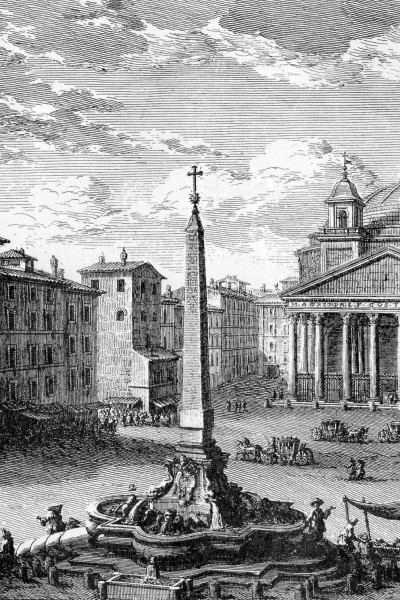
In 1711, the fountain received a makeover when Filippo Barigioni designed a new fountain basin and added one of the two Egyptian obelisks taken from the Temple of Ra in Heliopolis by Augustus after his defeat of Marc Anthony and Cleopatra. In 1886 the marble figures were removed and replaced with copies. If you want, you can see the original in the Museum of Rome in the Palazzo Braschi in the Piazza di San Pantaleo, just outside of the Piazza Navona.
The fountain is one of the great meeting places in all of Rome, as in, “I’ll meet you at the Pantheon fountain at 3pm.”
You’ll notice the slope of the Piazza by the fountain. One side has 5 steps leading up while the other side has 2 steps.
The Piazza actually follows the rectangular space of the ancient Pantheon courtyard. The Pantheon Temple was once raised up higher but the years of old civilization have eventually raised the street level so now the temple and street are the same level. The engraving above is from the 1750’s by Giuseppe Vasi.
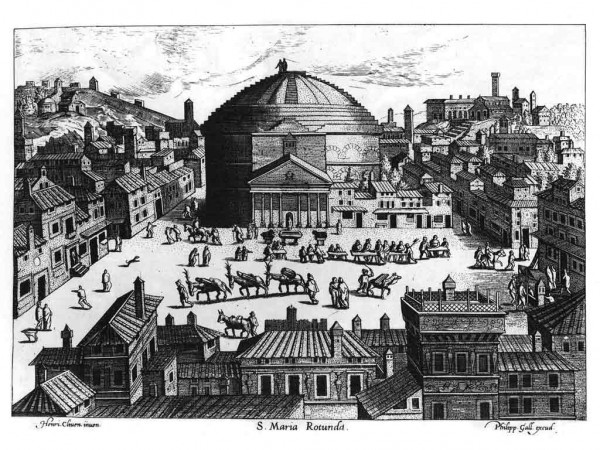
You can still see the holes in the exterior walls and in the columns of the portico of the Pantheon where a marketplace was once attached. The Piazza was the location of the city poultry market till the 18th century.
The Piazza was also the home of con men and scam artists from all over the city. Romans would pluck the chickens while thieves would pluck the Romans. The engraving above is from 1550.
In the early 19th century, Pope Pius VII (Chiaramonti) decided to clean up the area around the Pantheon and remove the food stalls and hucksters.
On the wall at the opposite end of the Piazza (from the Pantheon) is a plaque dedicated to the pious Pope Pius for his great achievement. It reads:
PIVS · VII · P · M · AN · PONTIFICATVS · SVI · XXIII ·
AREAM · ANTE · PANTHEON · M · AGRIPPAE IGNOBILIBVS · TABERNIS
DEMOLITIONE · PROVIDENTISSIMA
AB · INVISA · DEFORMITATE · VINDICAVIT
ET · IN · LIBERVM · LOCI · PROSPECTVM · PATERE · IVSSIT
Pius VII Supreme Pontiff, in the 23rd Year of His Pontificate the 23rd, freed the area of the Pantheon of Marcus Agrippa
of ignoble eateries and detestable deformity by undertaking a very thoughtful program of demolition to provide an unobstructed view of the site.
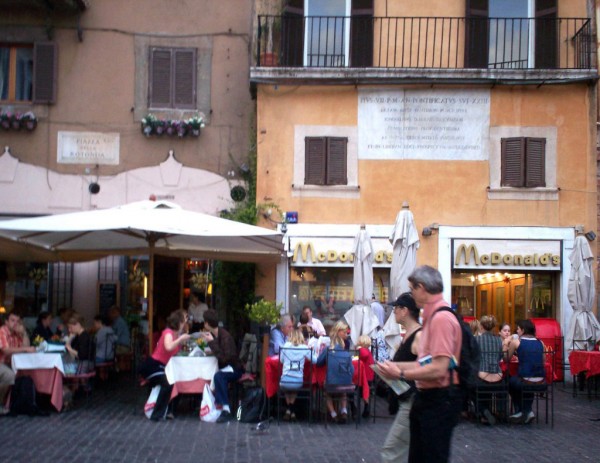
For years the Plaque sat directly over the ignoble McDonald’s fast food eatery of Piazza della Rotonda. It was a favorite of American tourists who mostly went in to use the bathrooms. No one seems to know why, nor do they really care, but alas, the Piazza Della Rotonda McDonald’s closed up in early 2011. For those of you who might be a bit saddened by the closure, don’t worry, there are 6 other McDonalds eateries in central Rome. The one near the Trevi fountain is less than a 15 minute walk away.
If you are looking for a good meal, here are a few solid recommendations:
Armando al Pantheon on Salita de’Crescenzi, 31 (around the corner from the Pantheon) has been a favorite of Romans since 1961. Lunch 12:30 – 3pm; Dinner 7pm-11pm; closed Saturday night and all day Sunday.
Trattoria da Cavalier Gino at Vicolo Rosini, 4, just off the via di Campo Marzio, is about a 5 minute walk from Piazza della Rotonda. Since it is also very close to the Parliament Building, this is a great lunch where you can sit and watch the Italian politicians dine. Open Lunch/Dinner 12:30pm-11:00pm, closed Sunday.
We’ve also had a few good meals at Ristorante L’Angoletto at Piazza Rondanini, 51, about a 5 minute walk from the Pantheon. Dinner: 7:30pm – 11:30pm. Closed Monday.
The two best coffee shops in all of Rome are within 4 minutes of the Pantheon. In the Piazza della Rotondo is the Tazza d’Oro and about a 5 minute walk away in Piazza Sant’Eustachio is Caffe Sant’Eustachio .
If you’re looking for a hotel in or near the Pantheon there are a few good choices.
The Albergo del Sole, one of the oldest hotels in the city dating back to 1467. It was called the Locanda del Montone (the Ram’s Inn) till 1613 and still occupies it’s original location in the Piazza. The lead in photo I used for this article was taken from a window in the Albergo del sole. The hotel has been lovingly restored with rates of around 250 euros /night.
It was here where the Giuseppe Balsamo, the infamous and mystical Count Alessandro di Cagliostro was arrested in 1768 for beating his servant. Cagliostro is one of the most infamous magican, alchemist, forger swindlers of all time. He’s the subject of countless movies, plays, operas and books. His exploits have been written about by Cassanova, Goethe, Dumas, Tolstoy, Umberto Ecco and Robert Anton Wilson.
In 1939, the Albergo Santa Chiara started out as a wine shop but soon after turned into a small 10 room Inn. Now it has 96 rooms in three adjoining buildings ranging from classical décor to high tech. It’s very comfortable, the management is very hospitable and the price is around 230 euros/night for a double room. You can still see some of the ruins of the Baths of Agrippa near the intersection of via de Cestari and the via dell’Arco della Ciambella, a block from the Albergo. The baths were built around the same time as Agrippa’s early version of the Pantheon. They were fed by the Aqua Virgo (now the Aqua Vergine). It’s the same water souce that now feed the Fountain in the Piazza della Rotondo and terminates at the Trevi Fountain. The baths became incorporated into the Church of Santa Chiara in the 16th century.
If you want to really splurge, there is the 5 star Grand Hotel de la Minerve behind the Pantheon and across the small Piazza della Minerva from the Basilica di Santa Maria Sopra Minerva. It’s a fabulous hotel, originally build as a grand Palazzo in 1620 for the Fonseca family and turned into a hotel in at the end of the 18th century. It is on the high end, about 350 euros/night in high season. However, check the hotel website for special rates.
Another great attraction very close to the Grand Hotel is the Gammarelli tailor shop. They’ve been providing clothing to the Popes since 1798. During the time of a papal conclave to choose a new Pontiff, Gammarelli will manufacture the robes, stoles, hats and shoes for the induction ceremony. They’ll make them in 3 sizes (large, medium and small) in order to have one of them ready for whoever is elected. During the conclave, the new clothes are on display in the front window.
And finally there are the gelato shops. I’m not a big fan of the big fluffy aerated mountains of gelato you’ll see in the Blue Ice shops or many others. They look fabulous but the taste just isn’t as good as the real home made variety.
Just off the Piazza della Rotondo is the ‘Fiocchi di Neve’ (snow flakes) on via del Pantheon, 51. Their gelato is excellent, milk shakes delicious and their café affogato (espresso poured over gelato) is amazing.
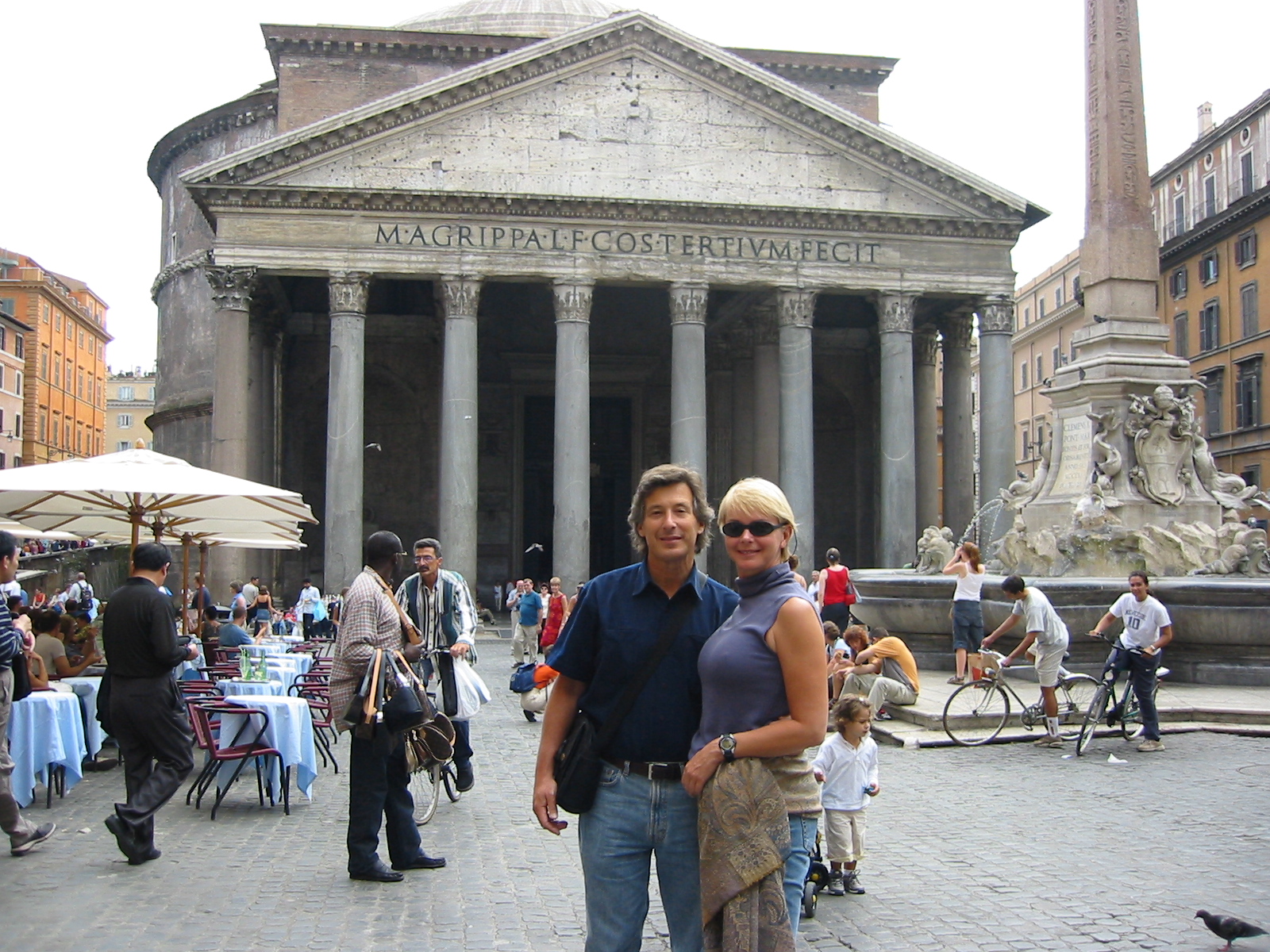 I know most tourists are attracted to the famous Gelateria San Crispino. I am not one of them. I’ll let the uninformed stand in line at san Crispino while I walk over to Fiocchi di Neve.
I know most tourists are attracted to the famous Gelateria San Crispino. I am not one of them. I’ll let the uninformed stand in line at san Crispino while I walk over to Fiocchi di Neve.
Here we are in 2000. The Pantheon has had a facelift in 2010. It looks even better these days.
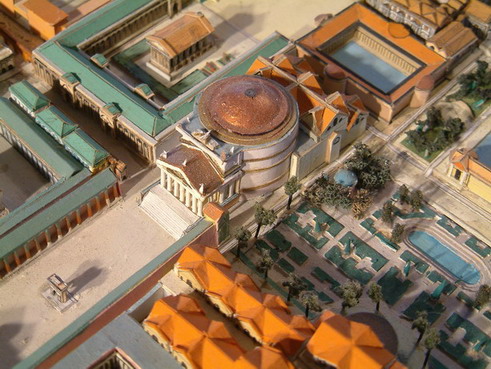
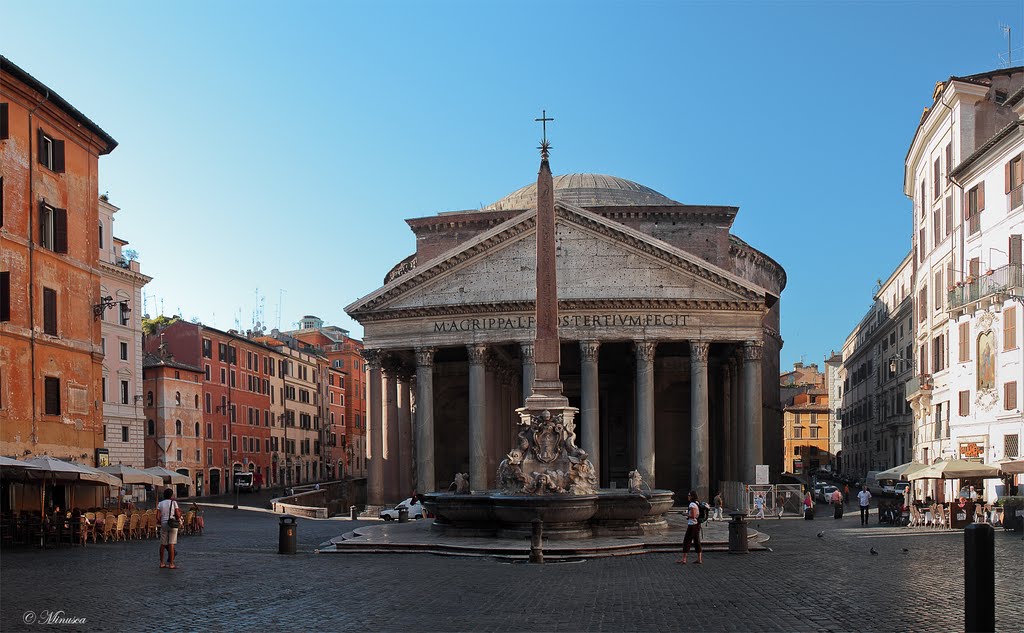
You must be logged in to post a comment.